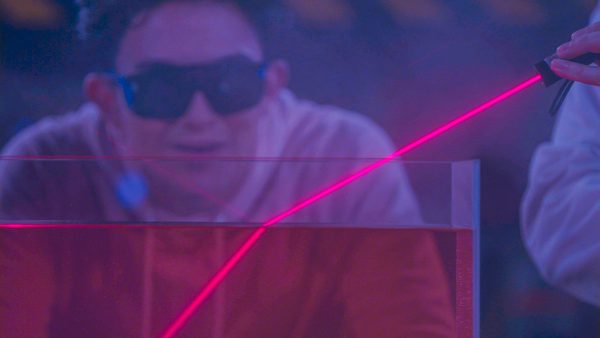Wave Reflection Definition
Wave reflection occurs when waves hit matter and bounce off. For example, sound waves create echoes by reflecting off surfaces.
View Lesson on Wave Reflection, Absorption & Transmittance
Become a member to get full access to our entire library of learning videos, reading material, quiz games, simple DIY activities & more.
Become a member to get full access to our entire library of learning videos, quiz games, & more.
Plans & Pricingto watch this full video.

Access All Videos
and Lessons, No Limits.
Access All Videos

No credit card required,
takes 7 sec to signup.
No card required

Ready-to-go lessons
that save you time.
Ready-to-go lessons
If you are on a school computer or network, ask your tech person to whitelist these URLs:
*.wistia.com, fast.wistia.com, fast.wistia.net, embedwistia-a.akamaihd.net
Sometimes a simple refresh solves this issue. If you need further help, contact us.
Wave Reflection, Absorption & Transmittance
Fun Facts
- When a wave is reflected, it is sent off in a new direction.
- Light reflects off mirrors at equal angles of incidence and reflection.
- Waves are reflected when the density of matter is too high for the wave to pass through or be absorbed.
Why Do We Need To Know About Wave Reflection
Learning about how waves of sound and light bounce off things or get soaked up helps us understand how they work with different materials. This is really important for making things better in many jobs. For example, music studios use special foam to soak up sound so there’s no echo, making the music sound clearer. This shows how knowing about waves helps make better sound for music.
In the same way, how light waves bounce off or get soaked up is key for things like solar panels that turn light into electricity, and for plants making their food in photosynthesis when leaves reflect green light. These examples show us how waves are important in making clean energy, new technologies, and even in how nature works.
Frequently Asked Questions
Check out the Full Lesson on Wave Reflection, Absorption & Transmittance
In this lesson, we learn that:
- All waves have properties like amplitude, wavelength and frequency.
- Sound waves need matter to travel through. Light waves can travel through empty space.
- Waves interacting with matter can be reflected, absorbed, transmitted and refracted.
Related Topics
- Astronomy Definition
- Biomimicry Definition
- Cell Definition
- Chromosome Definition
- Circulatory System Definition
- Condensation Definition
- Convection Definition
- Electromagnetic Radiation Definition
- Endoskeleton Definition
- Engineering Design Process Definition
- Erosion Definition
- Freezing Definition
- Gravity Definition
- Invasive Species Definition
- Landslide Definition
- Larvae Definition
- Lever Definition
- Life Cycle Definition
- Light Reflection Definition
- Light Source Definition
- Light Year Definition
- Magma Definition
- Mineral Definition
- Mitochondria Definition
- Muscular System Definition
- Natural Selection Definition
- Newton’s 1st Law Of Motion Definition
- Nonrenewable Resource Definition
- Nucleus Definition
- Opaque Definition
- Orbit Definition
- Organelle Definition
- Paleontologist Definition
- Partial Eclipse Definition
- Pollution Definition
- Potential Energy Definition
- Reflecting Surface Definition
- Reversible Change Definition
- Rock Definition
- Snow Definition
- Solution Definition
- Taxonomy Definition
- Trace Fossil Definition
- Water Distribution Definition
- Water Quality Definition
- Wave Reflection Definition
- Wavelength Definition
- Weathering Definition


Start a Free Trial Today. Get a $5 Amazon Gift Card!
Teachers! Start a free trial & we'll send your gift card within 1 day. Only cards left. Try it now.
Select Grade
Select Subject
This email is associated with a Science Kit subscription. Kit subscriptions are managed on this separate page: Manage Subscription

-
Download InvoiceScience & Math$/yr
-
Download InvoiceScience Only$/yr

access all lessons
• No credit card required •
"My students loved the videos. I started the video subscription in May and used them as a review before the state test, which I know contributed to 100% of my class passing the state test."
Rhonda Fox 4th Grade Teacher, Ocala, Florida
Use Generation Genius in Your School
Access all lessons free for 30 days.
"My students loved the videos. I started the video subscription in May and used them as a review before the state test, which I know contributed to 100% of my class passing the state test."
Rhonda Fox 4th Grade Teacher, Ocala, Florida
• No credit card required •
Already a member? Sign In
* no credit card required *

* no credit card required *
* no credit card required *

Get District Quote
Discounts start at 3 schools.
Sent!
Thank you for your inquiry.
We will email you a quote as soon as we can.

to Discover the Benefits of Generation Genius
Learn How to Save for Your School & District!
Please login or create an account to access additional resources

no credit card required
Skip, I will use a 3 day free trial
Enjoy your free 30 days trial
-
Unlimited access to our full library
of videos & lessons for grades K-5. -
You won’t be billed unless you keep your
account open past your 14-day free trial. -
You can cancel anytime in 1 click on the
manage account page or by emailing us.
-
Unlimited access to our full library of videos & lessons for grades K-5.
-
You won't be billed unless you keep your account open past 14 days.
-
You can cancel anytime in 1-click on the manage account page.
Cancel anytime in 1-click on the manage account page before the trial ends and you won't be charged.
Otherwise you will pay just $10 CAD/month for the service as long as your account is open.
Cancel anytime on the manage account page in 1-click and you won't be charged.
Otherwise you will pay $10 CAD/month for the service as long as your account is open.
We just sent you a confirmation email. Enjoy!
Done



























































































































 GENERATION GENIUS
GENERATION GENIUS